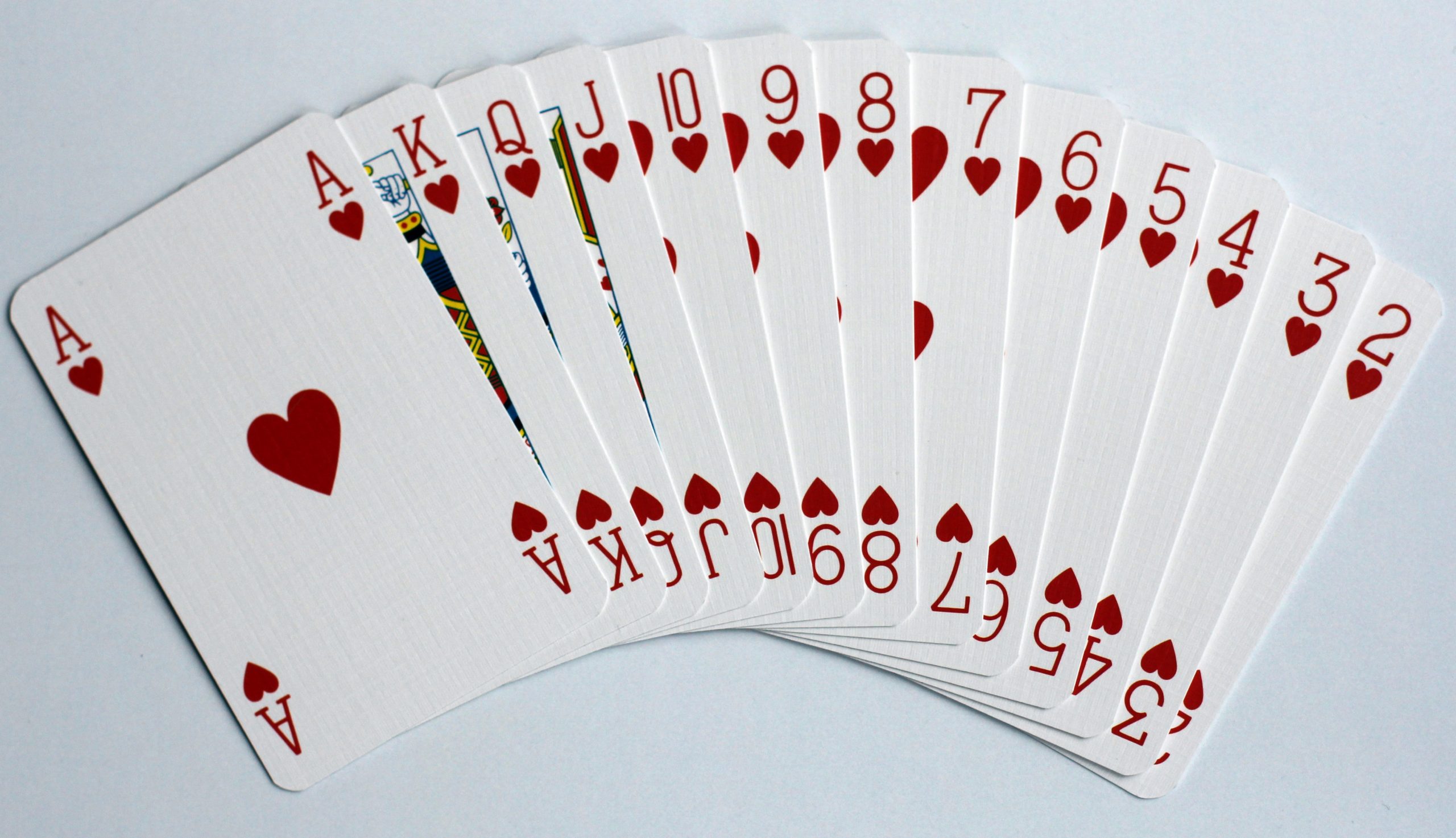Hearts is a card game that can be played with four players.
The game is played with a deck of 52 cards, and the objective is to have the lowest score at the end of the game.
While the game can be played in person, Hearts can also be played online against the computer or live against other players.
Table of Contents
How to Start A Game of Hearts
“Hearts” is a classic card game that is played with a standard deck of 52 cards.
Here are the basic principles for playing the game:
- Objective: The main objective of the game is to avoid collecting certain cards that carry penalty points. Typically, you want to avoid getting any of the Heart cards (which each carry 1 penalty point) and the Queen of Spades (which carries 13 penalty points). The player with the fewest points at the end of the game is the winner.
- Setup: The game is usually played with 4 players, and the entire deck is dealt out, giving each player 13 cards.
- Passing Cards: At the beginning of each round, players choose three cards to pass to another player. The direction of passing rotates with each round: to the left, to the right, across, and then no passing in the fourth round. The cycle then repeats.
- Leading a Trick: The player holding the 2 of Clubs leads the first trick. Players cannot lead with a Heart card or the Queen of Spades until Hearts have been “broken” (played in a previous trick).
- Playing a Trick: Players must follow suit if they can. If they cannot follow suit, they can play any card. The highest card of the leading suit wins the trick, unless a card from another suit is played that does not follow the leading suit, in which case the highest card of the leading suit still wins.
- Breaking Hearts: Hearts cannot be played as the first card in a trick unless they have been “broken” in a previous trick. This means a Heart card has been played because the player could not follow the leading suit.
- Scoring: At the end of each round, players tally their penalty points based on the Heart cards and the Queen of Spades they have collected in the tricks. The game continues until one player reaches a predetermined number of points (e.g., 50 or 100), at which point the player with the fewest points is declared the winner.
- Shooting the Moon: This is a special strategy where a player tries to collect all the Heart cards and the Queen of Spades in one round. If successful, they can choose to either subtract 26 points from their own score or add 26 points to every other player’s score.
- Strategy: While the basic rules are simple, there’s a lot of strategy involved in deciding which cards to pass, when to play certain cards, and whether to try and “shoot the moon”.
- Fair Play: As with all games, it’s important to play fairly and respectfully. This includes not signaling to partners or using any form of cheating.
The specific rules and variations can differ based on regional or house rules, so it’s always a good idea to clarify the rules with all players before starting a game.
Tips for Playing Hearts
“Hearts” is a game of skill, strategy, and sometimes, a bit of luck. Here are some strategies to consider when playing the game:
- Avoid Points Early On: Especially if you’re new to the game, try to avoid taking any points in the early rounds. This will give you a better sense of other players’ strategies and allow you to adapt your play.
- Pass Wisely: Think about the three cards you’re passing. If you’re passing to the left and you have the Queen of Spades but not many other Spades, it might be a good idea to pass the Queen to make it someone else’s problem.
- Control the Queen: If you’re going to take the Queen of Spades, make sure you have enough Spades to control when it comes out. Alternatively, if you don’t have the Queen but have many other Spades, try to draw it out from another player.
- Bleed Out the Spades: If you don’t have the Queen of Spades, try to play your higher Spades when you know she won’t come out, to increase the chance that she’ll be played when you’re not vulnerable.
- Watch the Clubs: Remember, the player with the 2 of Clubs starts, and no points can be played on the first trick. If you have a high Club, you might be safe to play it early.
- Keep Track: Try to remember which high cards (especially Hearts and the Queen of Spades) have been played. This can guide your decisions in later tricks.
- Break Hearts: If you have a lot of high Hearts and are likely to take some tricks with them, consider “breaking hearts” early, especially if you can do so on a trick where you won’t take any points.
- Avoid Shooting the Moon Unless You’re Sure: Trying to take all the Hearts and the Queen of Spades is high-risk, high-reward. If you’re going to try, be sure you have a good hand for it and that you have a plan for each suit.
- Stay Flexible: Your strategy might need to change based on the cards you’re dealt, the cards you’re passed, and the way the first few tricks play out. Stay adaptable!
- Use Low Cards to Your Advantage: If you have a lot of low cards in a suit, you can use them to avoid taking tricks in that suit, which can be especially valuable if you’re trying not to take any points.
- Middle Cards are Tricky: Cards in the middle (like 7, 8, or 9) can be tricky since they might win a trick or might not. Be careful when playing them, especially in Hearts.
- Watch Your Opponents: If you play regularly with the same group, try to pick up on their habits and strategies. Some players might always try to shoot the moon with a certain type of hand, while others might always play conservatively.
As with any card game, there’s no one-size-fits-all strategy.
Your best approach will depend on your hand, your position, and your opponents.
The key is to stay adaptable and always be thinking a few tricks ahead!
How to Play Hearts
FAQs – How to Play Hearts
What is Hearts?
Hearts is a four-player trick-taking card game. The game begins with each player being dealt 13 cards.
The object of the game is to have the least number of points when one of the players reaches 100 points.
How do you score in Hearts?
The scoring in Hearts is relatively simple. Each heart card is worth one point and the Queen of Spades is worth 13 points.
At the end of each hand, the player with the most points loses and the other players receive a point for each heart they have in their hand.
What are some strategies for playing Hearts?
There are a few basic strategies that can be employed while playing Hearts.
One is to try and avoid taking points whenever possible. This can be done by leading with high cards, such as the Ace, King, or Queen. Another strategy is to try and pass low point cards to other players.
Finally, it is often beneficial to save the Queen of Spades until late in the game when it can be used to take all 13 points from another player.
What is the history of Hearts?
The game of Hearts has a long and storied history. It is thought to have originated in Spain in the early 1500s.
From there, it spread to France and eventually made its way to America in the 1800s. The game has remained popular ever since and continues to be enjoyed by millions of people around the world.
Hearts is what percent skill and what percent luck?
Hearts might be thought of as about 70% skill and 30% luck.
The balance between skill and luck in the card game “Hearts” is a subject of debate and can vary based on the players involved, the specific rules being used, and individual game circumstances.
However, here’s a general breakdown:
- Skill (70%):
- Strategy: Experienced players develop strategies for passing cards, leading suits, when to break hearts, and whether to attempt “shooting the moon.” Understanding the risks and rewards of each decision and adapting to the flow of the game is crucial.
- Memory: Keeping track of which cards have been played can give players a significant advantage, especially when it comes to avoiding high-point cards in later tricks.
- Reading Opponents: Over time, players may pick up on the habits and tendencies of their opponents. Recognizing these patterns can offer strategic advantages.
- Adaptability: The best players can quickly adjust their strategies based on the cards they’re dealt and the evolving game situation.
- Luck (30%):
- Card Distribution: Players have no control over the cards they’re initially dealt or the cards they receive from other players during the passing phase. A particularly bad or good hand can significantly influence the outcome of a round.
- Unpredictable Plays: Even if a player has a strong strategy, unexpected plays by opponents can disrupt plans. For example, an opponent might unexpectedly “shoot the moon,” drastically changing the point distribution.
While luck plays a role in “Hearts,” especially in any single hand or round, skill is the dominant factor over the long run.
Consistently successful players use strategy, memory, and adaptability to navigate the challenges of the game and mitigate the impact of bad luck.
However, the exact percentages can vary based on individual opinions and experiences.
Conclusion – How to Play Hearts
Hearts is a fun and challenging card game that can be enjoyed by people of all ages.
By following the basic strategies outlined above, you can increase your chances of winning.
Most importantly, remember to have fun and enjoy spending time with your friends and family while playing Hearts.
Related
- Best Casino Card Games
- How to Play Baccarat
- How to Play Roulette
- How to Play Blackjack
- How to Play Craps
- How to Play Klondike
- How to Play Crazy Eights
- How to Play Uno
- How to Play Rummy
- How to Play War
- Poker Tips
- Best Casino Slots
- What is iGaming?


